News of the Day

Dec. 28, 1980: Shunkaha, aka Shunky, “Hound of Hounds,” is 6 years old
So begins a long, delightful, colorful and sometimes strange journey through the 1980s, as experienced by a civilian Department of Defense employee, a 1970s KU alumnus then working at Fort Leavenworth who filled his official U.S. government desk calendars with felt-pen drawings and precise annotations about the world.
The wide world. The private world. His dog. The Cold War. Ronald Reagan. KU basketball. Perilous personal health scares. A few veiled nods to Wiccan religious beliefs, as well as seasonal reminders about important holidays for Christians and Jews and a regular log of snowfall totals and notably heavy rains.
The Iranian hostage crisis. Congressional business, both explosive and mundane. Presidential speeches and an assassination attempt. Visits to Fort Leavenworth by U.S. Army generals. International Women’s Day. Postal rate increases for first-class stamps (featuring a bandana-clad bandit). Co-workers’ retirement parties. Precise, ongoing accounting of vacation days and sick days. Soviet troops into Afghanistan in April 1981 and out of Afghanistan in February 1989.
“Even though we didn’t have the internet, and we didn’t have the constant news, the creator of these was really plugged in and was really good at processing events on a global scale, which I think is fascinating,” says Beth Whittaker, c’92, g’94, director of the Spencer Research Library and KU Libraries’ assistant dean for distinctive collections, who in July 2018 purchased the calendars for the Spencer’s collections. “At the same time, this man was living his life. He was observing and processing and going about the work; not only his own professional work, but the work of being alive in that time and place with a sense of reflection.”
Now titled “Illustrated Cold War Calendars,” these government issue desk calendars for 1981 through 1989—except, unfortunately, 1988—came to Whittaker’s attention thanks to the creator’s many KU basketball references and Jayhawk drawings, which were cited in an online catalog published last year by Boston Rare Maps.

When the online catalog of a respected dealer in antique maps also included these desk calendars—difficult to categorize, but certainly not maps, antique or otherwise—they intrigued The Paris Review and Atlas Obscura, both of which were charmed by the description provided by Boston Rare Maps as well as accompanying images.
“On any given day,” Ted Widmer wrote in the June 13, 2018, Paris Review, “the rare-book trade can cough up anything from an illuminated medieval manuscript to the pages of an unfinished novel. This week, an unusual offering caught my eye: an illuminated manuscript that was not medieval at all.”
Citing the calendar’s creator as “a nameless Cold Warrior,” Widmer continued, “Like a monk, he labored over his document every day, adding carefully crafted letters and elaborate drawings to what became, over nine years, a remarkably full chronicle of the decade.”
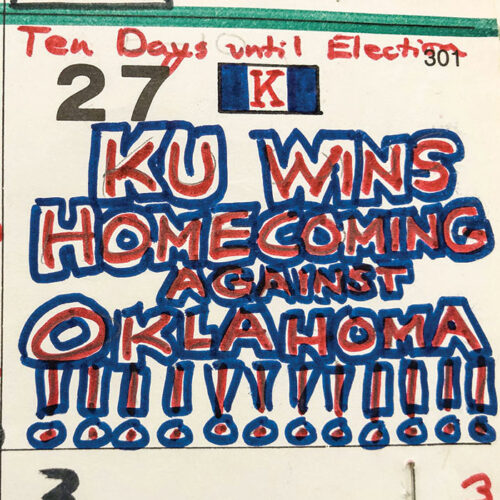
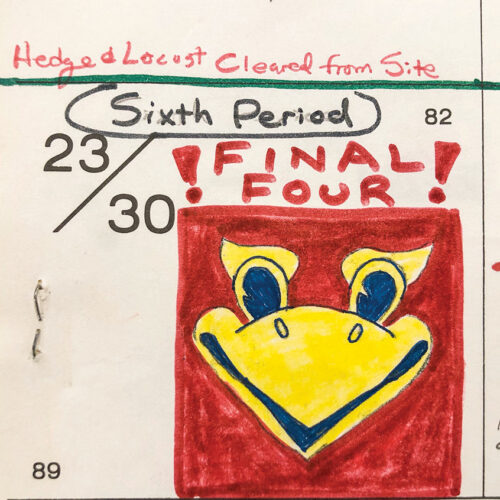
Both Widmer in The Paris Review and Sarah Laskow in the June 14, 2018, Atlas Obscura noted the calendars’ frequent celebrations of KU basketball; those references were seen by Jayhawks in Whittaker’s social media circles, who gleefully passed along links.
Whittaker was intrigued. She promptly asked colleague Sherry Williams, who has since retired as curator of the Spencer’s Kansas Collection, to contact Boston Rare Maps and place what’s known in the trade as a “reserve,” which essentially gives a potential buyer right of first refusal.
“I’m glad we did,” Whittaker says, “because then it really took off. These were kind of a hot ticket.”
Michael Buehler, the dealer, agreed to grant KU Libraries the reserve, but also asked a favor: Although items on reserve typically disappear from public view, he requested permission to display them at his booth in the dealers’ room at an upcoming rare books and manuscripts conference in New Orleans.
“I didn’t even get into the room,” Whittaker recalls with a laugh, “before I had several of my professional colleagues coming up and pointing and saying, ‘Have you seen that table that has the stuff with the Jayhawks?’ I said, ‘Yes, yes, yes,’ but since we hadn’t purchased them yet, I wasn’t saying they’re ours. So it was hard for me to keep quiet about it.”
With the calendars available for her inspection at the conference, Whittaker was overwhelmed. The purchase was finalized within two weeks.
“They were everything we had hoped; even better than we had hoped,” Whittaker says. “It was great. He got a lot of attention for his booth, KU got a lot of love, and we got these amazing calendars.”
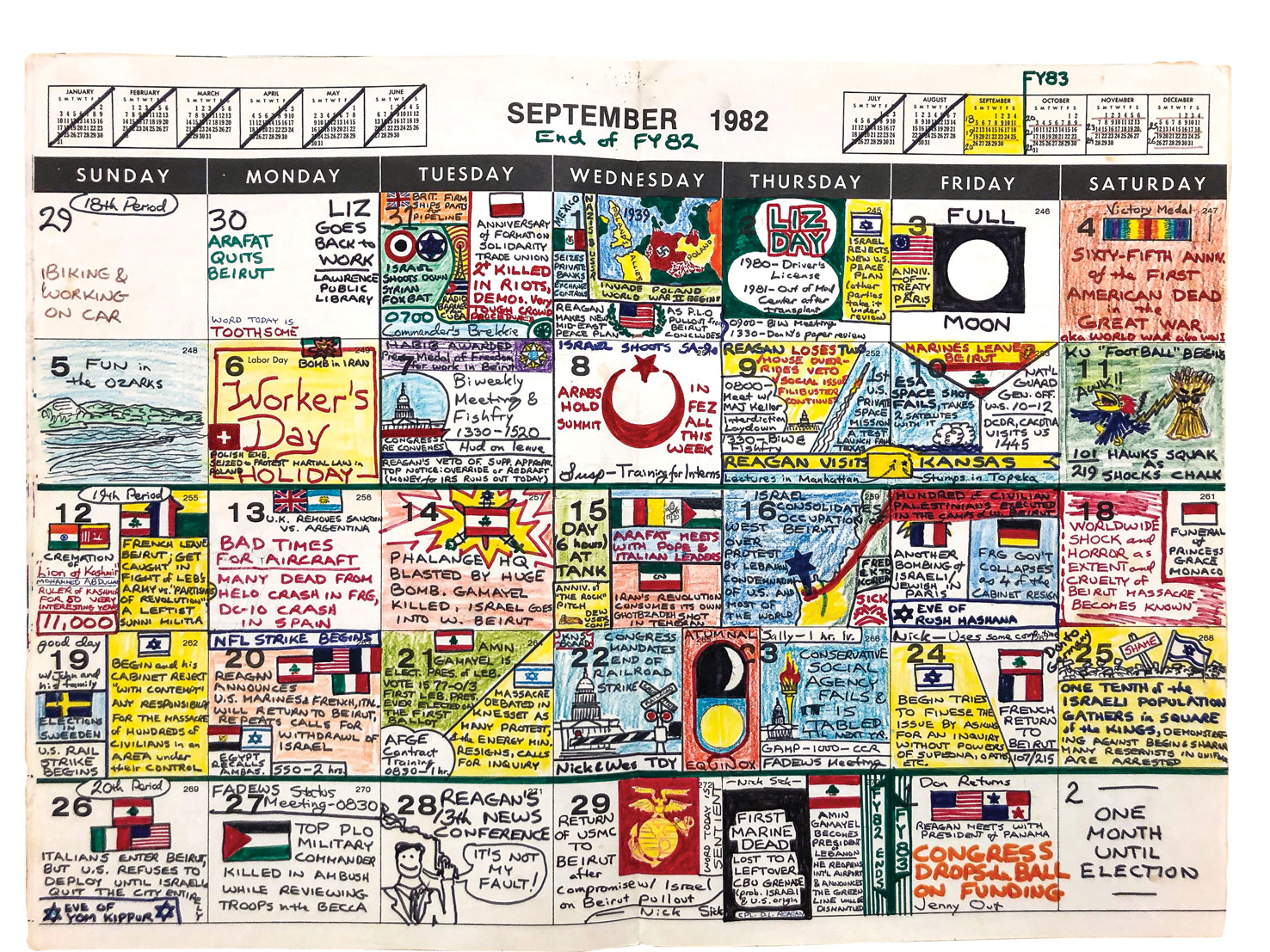
Spend time with these personal artifacts of the 1980s and a thought comes quickly to mind: They were desk calendars in name only. The heavily illustrated pages are virtually pristine. There are no coffee cup rings or soup spills. If one also considers that the calendars contain details of the illustrator’s private life and his political beliefs—he was not a fan of President Reagan, probably not a popular opinion around Fort Leavenworth at the time—it’s almost certain that they weren’t actually kept out on his desktop.
Stashed away inside a credenza, perhaps, or behind a bookcase?
Other uncertainties emerge. Were the entries created on or close to the day whose events they chronicle, or were separate notes kept and illustrated updates added, say, weekly? Some visible pencil lines indicate he might have first sketched some drawings before finishing with his office-supply felt-tipped pens, but others appear to be deftly freehand.
“I think it says something that, even for his creative work that he spent so much time and energy on, he used the tools he had available,” Whittaker says. “He didn’t go and buy a fancy notebook or special pens or anything like that. This is a government issue desk calendar that would have been what anyone else could have had, but what he made of it was something pretty extraordinary.”
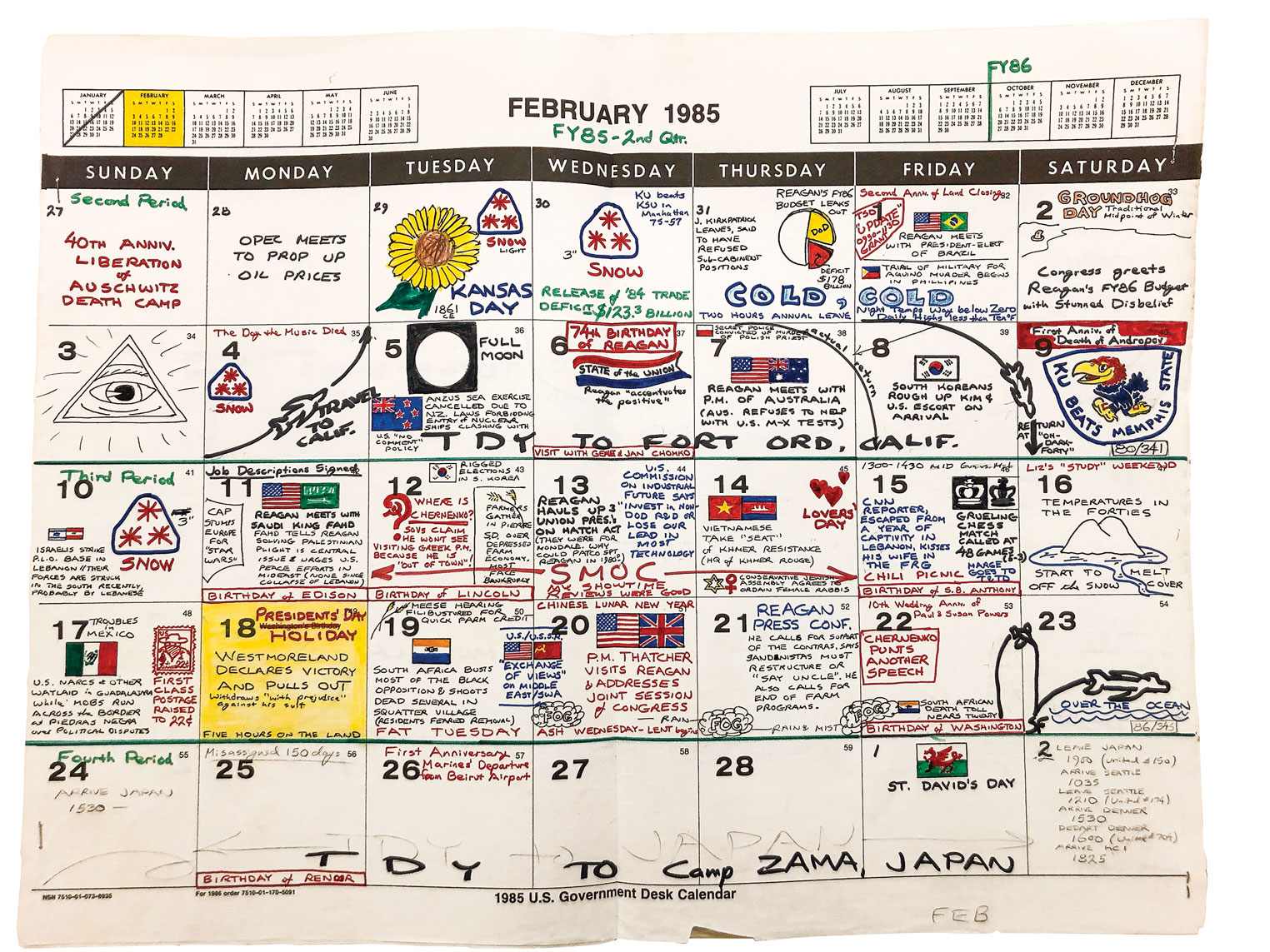
Aug. 18, 1981: Country Club Week all week
Jan. 8, 1984: Beirut blows up again after some rumors of settlement (With, as repeated throughout, a drawing of the national flag of the country mentioned.)
Jan. 28, 1986: Space Shuttle Challenger is lost with all hands
Feb. 8, 1981: Polish Union/Gov’t talks collapse, strikes widespread
March 24-25, 1989: Huge oil spill in Alaska
July 28, 1984: A moving opening for the Olympics
Jan. 29, 1986: Kansas Day 125!
“They’re an unusual window into one person’s life and the world as he saw it—a unique history of the 1980s, captured in pen, pencil, and felt-tip pen,” Laskow wrote in Atlas Obscura. “Looking through the months is a bit like looking through a Where’s Waldo? book, chock full of worldly details and small surprises. Go ahead—get lost in his world.”
When Boston Rare Maps advertised the calendars, the dealer chose to identify the illustrator as “a mid-level (GS-11/12) civilian planner and operations officer/analyst who worked for the Department of Defense at the U.S. Army’s Combined Arms Combat Development Activities (CACDA).” The listing goes on to surmise, “Apparently he retired after 1989, just before CACDA was downsized following the end of the Cold War.”
The online summary aptly describes the illustrations as “the sustained work of an able draftsman and cartoonist … who was both a government insider and an outsider to mainstream American society.”
While noting an intriguing sampling of domestic and international affairs included on a decade’s worth of calendar pages, the description continues, “In aggregate the calendars appear to track an imminent global apocalypse, presided over by President Reagan. Indeed, his feelings about the Reagan presidency are clear.”
The collection also includes a small collection of newsletters and instructional materials from two “pagan networks” in rural Oregon, where the illustrator and his wife apparently moved after his retirement, and a sharply worded letter to the ABC television network—dated “May 14, 1991 ce / In the waxing moon”—decrying harmful stereotypes about witches promulgated in a proposed ABC program titled “The Craft.”
The illustrator and wife included their names on the document—identifying themselves as “Witches, Citizens, Consumers”—but their full names appear nowhere else in the collection. Boston Rare Maps chose to not publicize their names, instead emphasizing the Everyman aspect: Here’s a guy who worked for the government, obviously a patriot with a deep mistrust of that era’s political leadership, who harbors a love of family, alma mater, state and country, and fervently hopes for a world in which all can practice their political and spiritual beliefs in peace and harmony.
As academics and researchers obligated to describe the full content of their holdings, KU librarians included the illustrator’s name in the collection’s online catalog listing, so it is now public information. After much discussion and consideration, however, Kansas Alumni chose to keep their names out of this article.
We can confirm that the illustrator is a 1975 College graduate, and his late wife, who died in 2001, earned her College degree in 1987. (Indeed, milestones in her academic journey are noted with pride throughout the calendars.)
Kansas Alumni did attempt to reach the illustrator, but our most recent official information about his whereabouts is out of date and Facebook Messenger queries generated no response. We can report that—if we did, in fact, find the correct Facebook page—he appears to be living a happy life in a lovely locale.
Lacking the opportunity to discuss these calendars with him, however, we chose to retain the anonymity of their initial public splash. The emotional and intellectual connections they inspire are not about the specifics of who, exactly, created these calendars, but rather that a sincere, hardworking Kansan deployed his talent for insight, observation and illustration to leave us with a dazzling collection that documents, in a beautifully unique voice, life here in the 1980s.
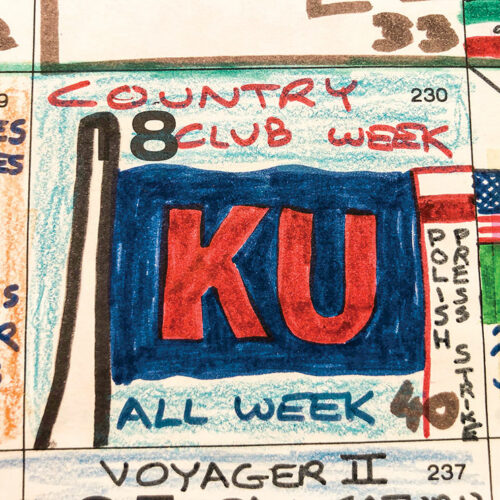
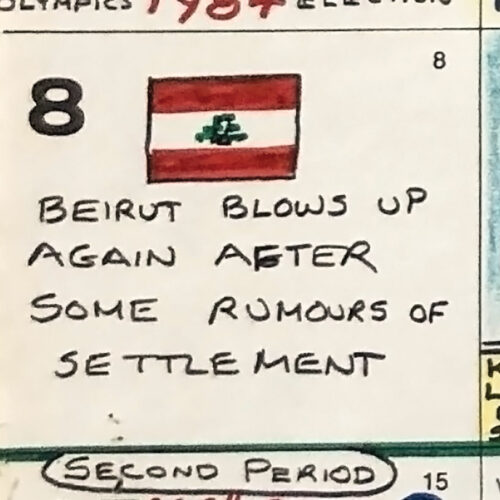
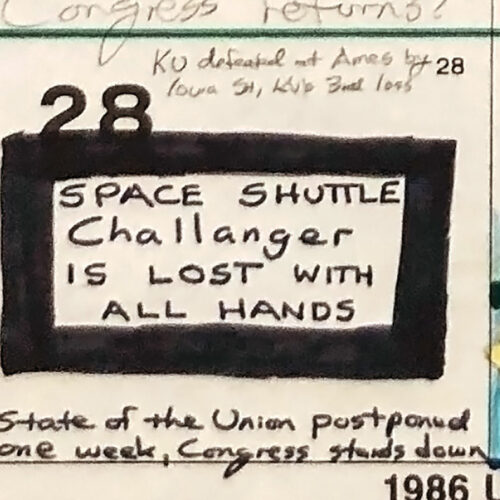
“The Kansas Collection,” Whittaker says, “documents the lives of everyday Kansans. That’s its mission.” She adds that while the Spencer Research Library boasts extensive Kansas-related holdings through the mid-20th century, the 1980s is “definitely a hole that these will fill.”
An unexpected joy of reading through a decade of personal desk calendars comes in the emergence of narrative storylines: Poland’s Solidarity movement, supply-side economics, California’s Mediterranean fruit fly crisis, turmoil in the Middle East, anniversaries marking the creation of the Berlin Wall and, ultimately, its fall.
More powerful, though, are the personal journeys. His wife’s illness, through which she persevered and continued her KU education; detailed weather reports, including the June 19, 1981, tornado that “rips Lawrence / 1 dead”; summer and winter solstices; moon phases and first frosts; spring plantings and new homes; and, on most Dec. 28ths, birthday wishes for man’s best friend.
As the calendars began, so they end: Dec. 27, 1989: Shunky the Dog is 15
Shunkaha, “Hound of Hounds,” made it, even if the decade’s final entry misses Shunky’s celebration by one day. So concludes a long, delightful, colorful and sometimes strange journey through the 1980s, as lived by one Kansas Everyman.